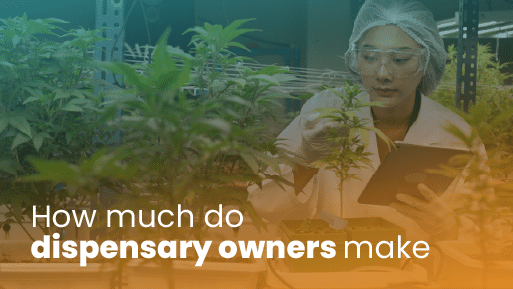On average, dispensary owners make between $250,000 and $500,000 annually—but that’s only after significant upfront investment and strategic management.
If you’re an aspiring cannabis entrepreneur, you can make a profit too. This guide breaks down earnings, costs, and smart ways to maximize your profits, so you can enter the cannabis game set to succeed.
? Key Takeaways:
- Dispensary owner profits vary widely depending on startup costs, staying compliant, and choosing the right location.
- Expenses like payroll, real estate, and inventory can erode margins if not carefully tracked.
- Marketing, customer engagement, and the right cannabis-compliant POS system are essential for scaling revenue.
How Much Does a Dispensary Owner Make?
Depending on location, overhead, and business model, owners can take home anywhere from 10-20% of annual revenue. A profitable dispensary can generate millions in revenue, with owners netting a healthy cut.
What Is the Cost of Running a Dispensary?
Dispensaries are expensive to run, and margins are slimmer than you might expect. From real estate to salaries to compliance, the startup and operational costs stack up quickly.
Here’s a peek into the estimated costs of opening an 1,800 square foot dispensary:
Feature | Price |
Application Fee | $5,000 |
Retail License Fee | $25,000 |
Real Estate (1,800 sqft) | $200,000 |
Renovations & Space Improvement | $50,000 |
Legal Fees & Professional Services | $30,000 |
Security & Surveillance | $30,000 |
Business Equipment | $25,000 |
Monthly Tech | $2,500 |
Inventory ($/lb) | $1,600 |
Annual Staffing | $240,000 |
Other Capital Needs | $100,000 |
TOTAL | $709,100 |
Initial Start-up Costs And Loans
To get started, you will likely need between $200,000 and $5M.
Unless you have your own cash assets to tap into, you will have to borrow money from a cannabis financing company, venture capital, or friends and family. This will most likely mean paying monthly loan installments or giving up part of your income equity.
❗Pro Tip:
Every state has a different cost for opening a dispensary. For example, California has a sliding scale for the cost of its cannabis retail license, while in Nevada, you will need around $250,000 in liquid assets.
Overhead Costs
Once you’re open, monthly expenses—like rent, payroll, insurance, and compliance—can quickly cut into margins. Planning for recurring costs is just as important as securing startup capital.
↳ Real Estate
Rent for a compliant dispensary space can range from $3K–$15K/month, depending on the market. Zoning restrictions and local politics often limit your options.
↳ Dispensary POS
Costs can range from $200/month for basics to $1,000+ for cannabis tech solutions, such as a cannabis-compliant POS system.
An excellent choice for tracking, compliance, and reporting is KORONA POS for small businesses.
↳ Employee Salaries
Depending on store size and location, expect to spend $150K—$500K+ annually on payroll. Most of your employees will be budtenders who earn between $15 and $20 an hour. Managers will require substantially more.
Inventory Costs
Expect to spend 40–60% of your revenue on inventory alone. Wholesale cannabis pricing fluctuates, and stocking flower, edibles, vapes, and more means upfront capital.
How Much Money Do Dispensaries Make?
Dispensaries can gross $1M–$10M+ per year, depending on several key factors.
Revenue is only one side of the equation—smart management turns revenue into actual take-home pay.
Location Is Critical
A dispensary in a high-traffic area will almost always outperform rural competitors. Foot traffic, local demand, and competition levels can make or break your business.
Even remote shops can attract long-distance shoppers, though. For example, dispensaries close to the New Mexico-Texas border attract a huge amount of out-of-state shoppers.
Strategies For Increasing Sales
Growth comes from strong marketing, tech tools, and customer engagement. Don’t rely on walk-ins alone—build a loyal customer base that keeps coming back.
↳ Menu And Delivery Apps
Dispensaries can expand sales channels by making their products available on apps like Weedmaps and Eaze. That’s because listing your products on delivery apps and online menus expands your reach.
↳ Social Media Marketing
Expanding your followers on Instagram means increasing your customer base. Use the platform as a way of showcasing everything you love about your company. Highlight your staff, educate your followers about the marijuana world, and promote new products.
Microbusinesses
One way to earn a higher income in the marijuana industry is to vertically integrate cultivation, production, and distribution. Some states have microbusiness programs that grant licenses to smaller-scale, artisanal, fully integrated cannabis enterprises.
5 Factors that Affect a Dispensary Owner’s Salary
Not all dispensary owners earn equally. Your revenue depends on a mix of strategy, location, compliance, and operations. Here are the 5 most important factors to consider:
Factor #1: State Regulations
Strict compliance rules can add complexity and cost. States like California and New York require constant reporting, which demands time and software.
Factor #2: Product Selection
A diverse, high-quality product line attracts repeat business. Focus on in-demand items like edibles, vapes, and topicals.
Factor #3: Customer Experience
Fast, seamless service leads to bigger basket sizes. Use a top-tier POS system made for dispensaries to make checkout simple, run loyalty programs, and track customer preferences.
Factor #4: Ownership Structure and Licensing Type
Whether you’re a sole proprietor, partner, or investor-backed operator changes your payout. Owners who hold multiple licenses or vertical integration can capture more profit across the supply chain, while corporate-style structures can generate higher revenue but split profits across several stakeholders.
Factor #5: POS Integration
Owners who invest in real-time data, inventory optimization, and KPI tracking typically earn more. A strong cannabis-compliant POS system, like KORONA POS, can reveal shrink, track employee performance, and ensure compliance—all of which directly impact take-home pay.
Tips for Increasing Profit as a Dispensary Owner
Want to move from survival to success? Here’s how top-performing dispensaries do it.
Tip #1: Monitor KPIs
Use POS data to track sales, inventory turnover, and customer data daily. Here’s a list of the top KPIs for dispensaries to stay profitable and compliant.
Tip #2: Upsell and Bundle
Bundling products can encourage larger purchases. You can also train staff to suggest add-ons like grinders or lighters at checkout.
Tip #3: Lean Into Loyalty Programs
Reward repeat customers with points or discounts. Loyalty programs not only increase revenue—they create customers that represent your brand and keep coming back for more.
Tip #4: Optimize Employee Scheduling
Overstaffing kills margins. You can use data to forecast traffic and schedule your employees accordingly.
Tip #5: Automate What You Can
Automation within your dispensary can reduce human error and save time. A smart POS platform like KORONA POS can automate tax reporting, inventory management, and more.

Maximize Your Dispensary’s Profits with the Right POS System
The right dispensary POS system doesn’t just process sales—it powers your entire operation. From customer insights to compliance reporting to inventory control, KORONA POS helps you run a smarter, more profitable business.
We provide our cannabis clients robust data analytics to help illuminate everything they need to know about their best-selling products, seasonal trends, and customer preferences. KORONA POS also integrates with cannabis platforms like Springbig to optimize your CRM, loyalty programs, and marketing strategies.
Frequently Asked Questions (FAQs)
How do I start a successful dispensary?
Start with a plan. Consider loans, finding real estate, and acquiring all necessary licensing. Once ready to open, nail down your niche market, compliance integrations, security apparatuses, and marketing outreach.
What is the cheapest state to open a dispensary?
The cheapest state to open a dispensary is Oklahoma. The state’s cannabis board requires a much lower than average licensing fee of $2,500 to get started. Also, the real estate, construction, and overhead costs are less expensive than most other legal states.
What is the easiest state to open a dispensary?
The easiest states to open a dispensary are Massachusetts and California. For Massachusetts, the state cannabis board offers a streamlined, digitalized, and expedited application process. The Golden State issues more licenses than any other state, including microbusinesses and multiple tiers of vertical consolidation.
What is the profit margin for a dispensary?
Most estimates put the average profit margin for a dispensary between 10% and 20%. The price of wholesale cannabis products fluctuates greatly, but even the lower end of dispensary margins presents an opportunity to make money.













